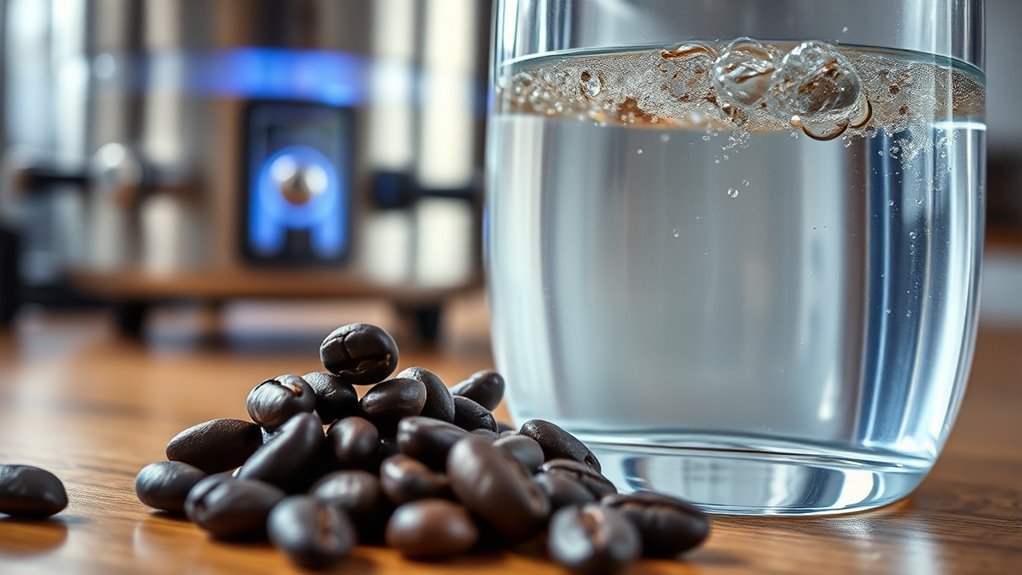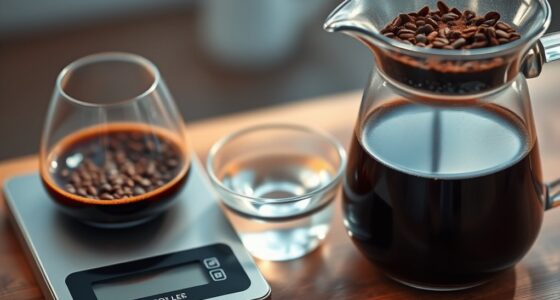If you want decaf without chemicals, both the Swiss Water and CO₂ processes are excellent options. The Swiss Water method uses only water to extract caffeine naturally, preserving flavor and aroma, making it eco-friendly. The CO₂ process employs supercritical carbon dioxide as a safe, recyclable solvent that maintains bean quality without chemicals. To learn more about how these methods work and their benefits, keep exploring the details behind these chemical-free decaffeination techniques.
Key Takeaways
- Both Swiss Water and CO₂ processes are chemical-free decaffeination methods.
- Swiss Water uses only water and charcoal filters, eliminating the need for chemicals.
- The CO₂ method employs supercritical CO₂ as a natural, recyclable solvent, avoiding chemical residues.
- These methods prioritize flavor preservation and eco-friendliness, ensuring no harmful chemicals remain.
- Certifications indicate these processes are safe, sustainable, and free of chemical solvents.
How the Swiss Water Process Removes Caffeine Naturally

The Swiss Water Process removes caffeine from coffee beans using only water and natural methods, making it an eco-friendly choice for decaf coffee. During caffeine extraction, hot water passes through the beans, dissolving the caffeine along with other soluble compounds. Because this process relies solely on water, there are no chemical residues left behind, ensuring a cleaner, more natural decaffeination. You won’t find traces of solvents or synthetic chemicals in your coffee, which appeals to health-conscious consumers. The process is gentle, preserving much of the coffee’s original flavor and aroma. By avoiding chemical-based methods, the Swiss Water Process offers a pure decaf option that’s both environmentally friendly and free of unwanted chemical residues, making it a popular choice for those seeking a natural decaffeination method. Additionally, this automation in decaffeination techniques helps reduce environmental impact and improves consistency in the final product.
Step-by-Step of the Swiss Water Method
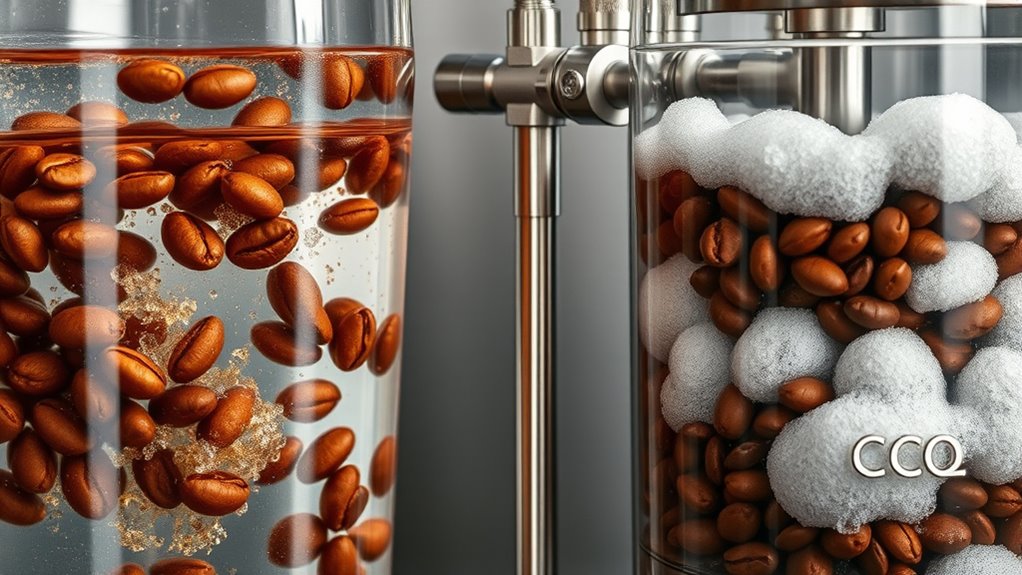
To decaffeinate coffee using the Swiss Water Method, you start by soaking green coffee beans in hot water, which dissolves caffeine and other soluble compounds. Next, you pass this water through activated charcoal filters that trap caffeine molecules, maintaining the flavor compounds in the water. This process is repeated in cycles until decaffeination efficiency reaches the desired level, typically removing 97% or more of the caffeine. Throughout, careful coffee bean selection is vital; only beans with similar chemical compositions are processed together to preserve flavor integrity. Since the method relies on water and filtration rather than chemicals, it’s gentle on the beans and maintains their original flavor profile. This step-by-step approach guarantees a chemical-free decaffeination that’s both effective and environmentally friendly. Additionally, Natural Language Processing (NLP) technology can be utilized to analyze customer feedback on decaffeination methods, helping producers improve their processes and meet consumer preferences.
The Science Behind the CO₂ Decaffeination Technique
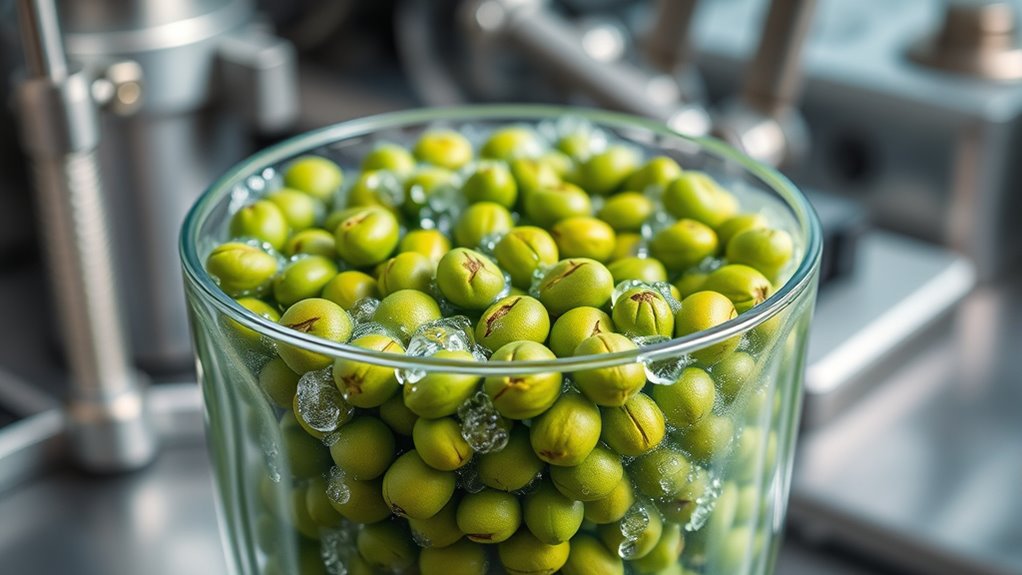
Building on the understanding of water-based decaffeination, the CO₂ technique leverages the unique properties of supercritical carbon dioxide to selectively extract caffeine. In this process, CO₂ acts as a solvent that penetrates coffee beans, targeting caffeine molecules with high precision. The supercritical state allows CO₂ to behave like a gas and a liquid simultaneously, enhancing caffeine extraction without affecting flavor compounds. This method minimizes chemical residues because it uses natural CO₂ instead of synthetic chemicals. Key points include:
- Supercritical CO₂ is non-toxic and recyclable
- Caffeine binds to CO₂ selectively, leaving flavor intact
- No chemical residues remain after processing
- It operates at lower temperatures, preserving bean quality
- The process is efficient and environmentally friendly
- The use of digital platforms in hackathons can facilitate collaboration and innovation in developing sustainable decaffeination technologies.
This technique offers a cleaner alternative for decaffeination, prioritizing safety and purity.
Comparing the Environmental Impact of Both Methods

When comparing the environmental impacts of water-based and CO₂ decaffeination methods, it becomes clear that each approach has distinct advantages and challenges. Water-based processes, like the Swiss Water method, typically use less energy, supporting environmental conservation efforts by reducing energy consumption. They rely on natural filtration and don’t require high-pressure equipment, minimizing resource use. Conversely, CO₂ decaffeination often involves higher energy consumption due to the need for pressurized chambers and specialized equipment, which can impact environmental sustainability. However, CO₂ methods are efficient and produce fewer chemical waste byproducts. Additionally, understanding the equipment requirements for each process can help assess their overall environmental footprint. Overall, if your goal is environmental conservation, water-based decaffeination generally offers a lower-impact option, but both methods are improving in their sustainability practices.
Benefits of Chemical-Free Decaffeination for Consumers
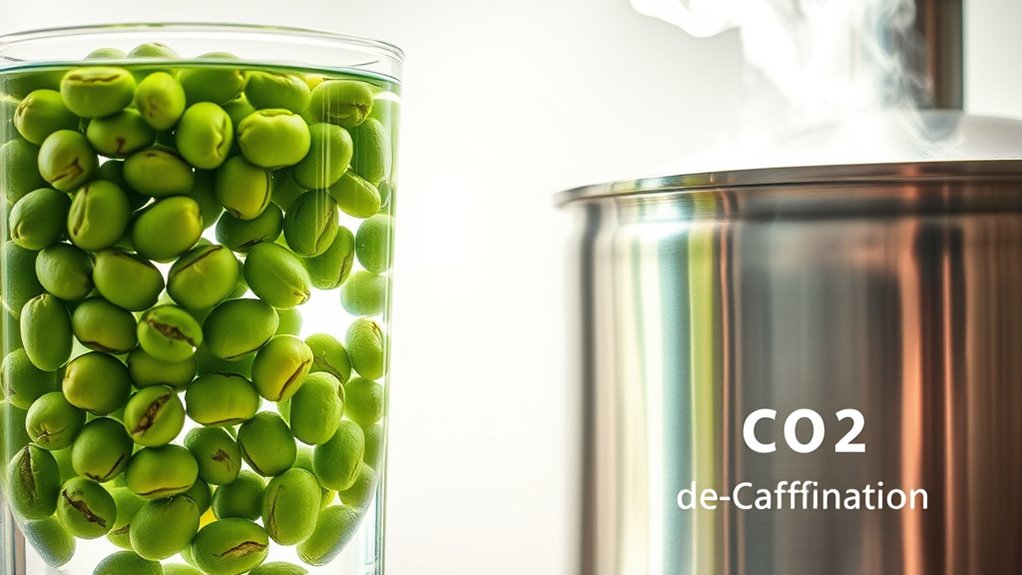
Chemical-free decaffeination offers significant benefits for consumers seeking a healthier coffee experience. Without synthetic chemicals, you reduce exposure to potential toxins, supporting your overall health. This method often aligns with organic farming practices, ensuring the coffee is grown without harmful pesticides or chemicals. The health benefits include fewer allergic reactions and lower risk of chemical residues. Additionally, chemical-free processes preserve the coffee’s natural qualities, making for a purer, more authentic cup. Here are some key advantages:
Chemical-free decaf reduces toxin exposure and preserves natural coffee flavors for a healthier, authentic experience.
- Reduced chemical exposure
- Support for organic farming practices
- Lower risk of allergies and sensitivities
- Preservation of natural coffee flavors
- Enhanced overall health benefits
Implementing chemical-free decaffeination techniques can also contribute to a more sustainable environment by minimizing chemical runoff and pollution.
Flavor Preservation in Swiss Water and CO₂ Decaf Coffee
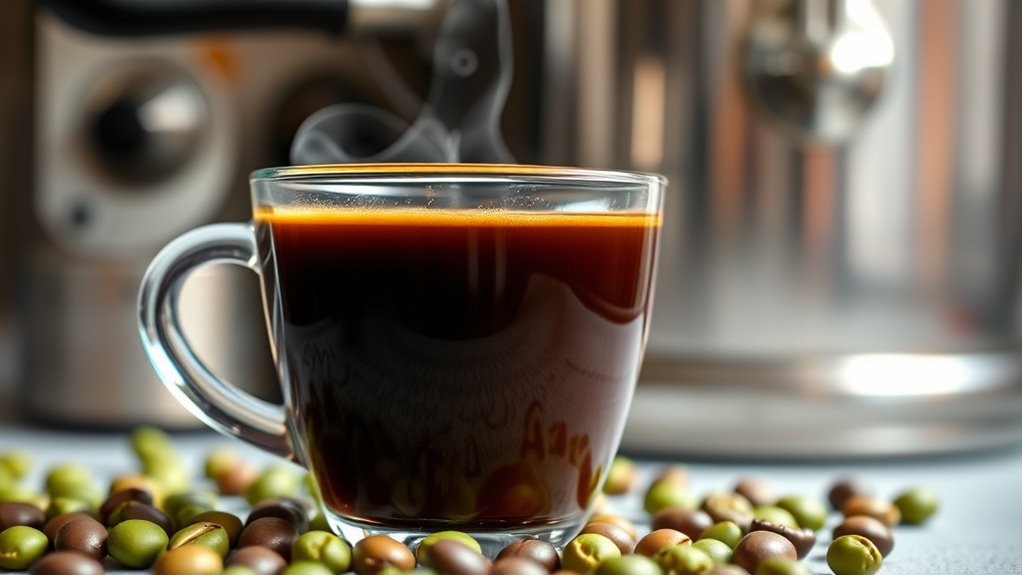
Both Swiss Water and CO₂ decaffeination methods are designed to preserve the coffee’s natural flavors, ensuring you enjoy a richer, more authentic cup. These processes excel in flavor retention by carefully removing caffeine while maintaining the beans’ nuanced aromas and tastes. Swiss Water relies on a gentle, water-based method that filters out caffeine without stripping away essential oils, maximizing flavor integrity. Similarly, the CO₂ process uses supercritical carbon dioxide, which selectively extracts caffeine while leaving most flavor compounds intact. This focus on process efficiency means you get decaffeinated coffee with minimal flavor loss. Both methods prioritize preserving the coffee’s original profile, so your cup remains vibrant, full-bodied, and true to its natural character—without sacrificing taste for decaffeination. Additionally, many specialty coffee shops prefer these methods because they align with the preference for clean and sustainable processes, which are often highlighted in the industry.
Choosing the Right Decaf: Which Method Suits You Best
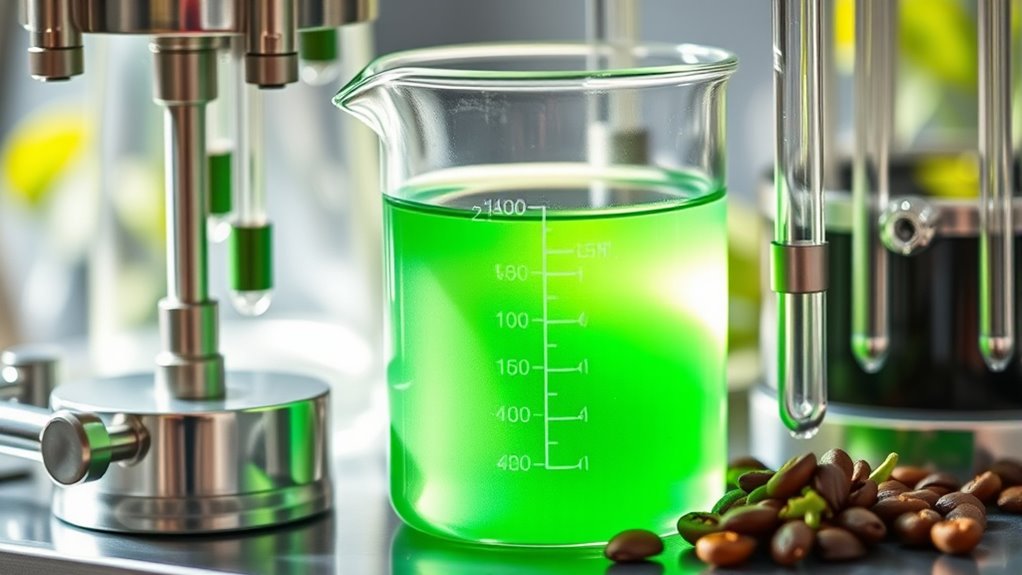
Choosing the right decaf coffee depends on your taste preferences and priorities. If you value organic certification and want to avoid chemicals, look for decafs that meet organic standards. Consider the flavor profiles you enjoy—some methods preserve bright, fruity notes, while others retain fuller body and depth. Additionally, understanding the inspirational quotes about dedication to quality can help guide your decision-making process. Deciding which process aligns with your needs:
- Swiss Water decaf for chemical-free, smooth flavor
- CO₂ decaf for richer, more complex profiles
- Organic-certified options for purity
- Flavor preservation techniques for specific taste preferences
- Certification labels indicating eco-friendly and chemical-free practices
Frequently Asked Questions
Are There Any Health Risks Associated With Chemical-Free Decaffeination?
You might wonder about health implications from chemical exposure during decaffeination. Fortunately, chemical-free methods like Swiss Water and CO₂ processes eliminate concerns about potential toxins. These techniques use natural solvents or water to extract caffeine, reducing any risk associated with chemical residues. By choosing decaf processed this way, you minimize health risks, making it a safer option for those sensitive to chemicals or seeking a healthier lifestyle.
How Do Decaf Coffee Prices Compare Between Swiss Water and Co₂ Methods?
Did you know that decaf coffee made with Swiss Water or CO₂ methods typically costs 10-20% more than traditional decaf? When you compare pricing, Swiss Water tends to be slightly pricier due to its meticulous, chemical-free process. Market availability also influences costs; Swiss Water decaf is often less common, making it a bit more exclusive. Overall, expect to pay a premium for chemical-free decaffeination methods like Swiss Water and CO₂.
Does Decaffeination Affect the Nutritional Content of Coffee?
You might wonder about the nutritional impact of decaffeination, but it generally doesn’t affect your coffee’s health benefits appreciably. The process mainly targets caffeine, leaving antioxidants and nutrients intact. Plus, flavor retention remains strong, so you still get a rich taste. Whether you choose Swiss Water or CO₂ methods, decaf coffee preserves most of its nutritional value, making it a healthy choice without sacrificing flavor.
Can I Find Decaf Coffee Made Without Any Chemical Processes?
Decaf coffee without chemicals? Yes, you can seek out natural methods like the Swiss Water Process and CO₂ extraction. These techniques prioritize purity, preserve flavor, and eliminate chemicals, giving you a clean, chemical-free cup. By choosing these processes, you enjoy decaffeinated coffee that’s both delicious and chemical-free. So, if you desire pure, chemical-free coffee, look for brands that emphasize natural decaffeination methods for a healthier, tastier brew.
How Long Does Each Decaffeination Process Take From Start to Finish?
Decaffeination timelines vary depending on the method used. For Swiss Water, the process typically takes about 8 to 12 hours, as water is used to extract caffeine gently. The CO₂ process generally lasts around 10 to 14 hours, involving high-pressure carbon dioxide to decaffeinate beans. Both processes are carefully timed to guarantee ideal flavor retention, so you’ll find process durations that balance efficiency with quality.
Conclusion
Now that you know how Swiss Water and CO₂ processes decaffeinate coffee naturally, imagine savoring that perfect cup without worry. Which method aligns with your values? The choice isn’t just about taste—it’s about trusting what’s in your coffee. As these innovative processes evolve, one thing’s certain: your next cup might hold more than just flavor. Are you ready to discover the true difference in your decaf? The journey to pure, chemical-free coffee starts now.
